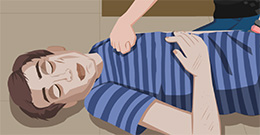- 70% of all drug overdose deaths in the US involve opioids.
- Opioid drugs include Fentanyl, oxycodone, Hydrocodone, heroin, tramadol, codeine, morphine, and methadone.
- Factors that Increase risk of opioid overdose include:
- Using or taking drugs while alone
- Mixing drugs
- Reduced tolerance from not having used the drug for a period of time
- Being sick or having a chronic disease
- Not knowing what drugs you are consuming
- Overdosing on opioids depresses the brain’s respiratory drive. Breathing slows excessively or stops entirely. Death is caused by lack of oxygen.
- Anyone can save a life during an opioid overdose by learning how to administer Narcan (Naloxone), a life-saving drug that reverses the effects of opioid overdose and restores breathing.
- Person is unconscious and unresponsive to loud sounds and painful stimuli like a sternal rub (i.e., using knuckles to push down and rub over the breastbone).
- Person has blue or purple lips and nail beds.
- Person is breathing too slowly, unevenly, or not at all.
- Person is making gurgling sounds.

- Call 911
- Administer Narcan (Naloxone), if available.
- Perform rescue breathing, if needed.
- If breathing is not restored within 2 to 3 minutes after 1st dose of Narcan (Naloxone), give a 2nd dose, if available.
- When the victim is breathing on their own, place them on their side in the recovery position until they are ready to sit up.

- Stay with the person until help arrives.
- Narcan is the antidote for an opioid overdose; it reverses the effects of opioids and restores breathing.
- Narcan comes in different forms. It can be administered by injection or by nasal spray.
- To reduce the risk of death from opioid overdose, the FDA recommends that the following people carry Narcan (naloxone):
- Individuals who take opioids and are at-risk for opioid overdose.
- Friends, family, and caregivers of individuals who take opioids.
- Narcan is safe to use in an emergency even if you’re not sure if the person has overdosed on opioids. Example: if someone is unresponsive and not breathing because of cardiac arrest or diabetic coma (i.e., NOT because of opioids) giving them Narcan will not cause any additional harm.
- People of all ages can safely use Narcan. It can be used for suspected overdose in infants, children, and the elderly.
If you are a student or employee and are at-risk for opioid overdose, or have friends, family members, or others that you care for, who are at risk for opioid overdose, please follow these two steps to obtain free Nasal Narcan:
- Take either one of these two FREE online trainings:
Bystander Naloxone Training (20 mins): A self-paced, step-by-step training.
This is the training recommended by your college nurse.
NOTE: You only need to complete the training. You are NOT required to make a donation or obtain a certificate of completion.
Administering Naloxone (12 mins) - Call or visit the Clovis Health Services Office in AC2-274W, (559) 325-5318 to schedule a time to pick up the medication. Before receiving the Narcan (Naloxone), you will need to verify that you have completed one of the online trainings listed above.








